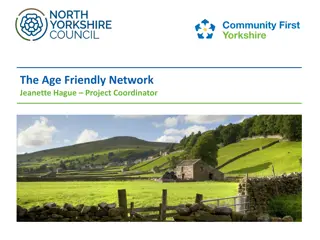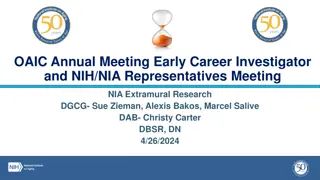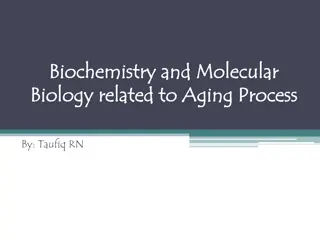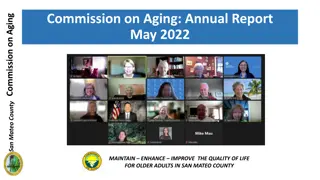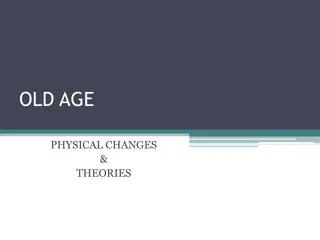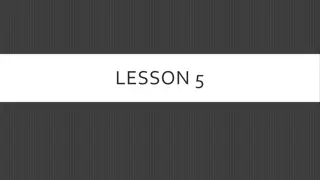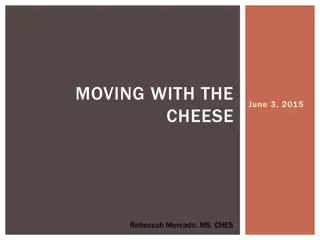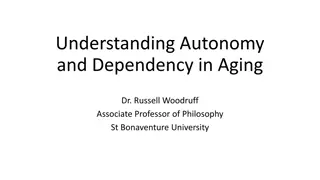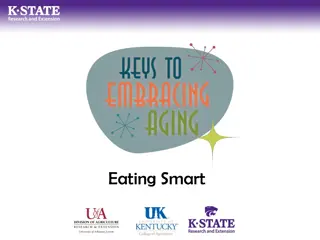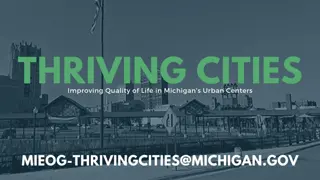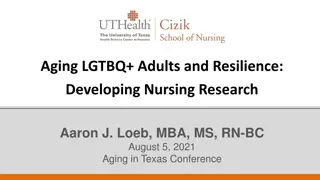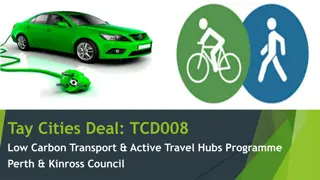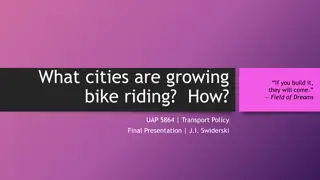Building Age-Friendly Cities for Active Aging
The concept of age-friendly cities goes beyond elderly care to focus on creating environments that facilitate active, independent living for older populations. With the number of elderly individuals increasing, it is crucial for cities to adapt and provide support in various domains such as social participation, mental well-being, and housing accessibility. Becoming a member of WHO's network for age-friendly cities can guide cities in implementing strategies to enhance the well-being and inclusion of older residents.
Download Presentation

Please find below an Image/Link to download the presentation.
The content on the website is provided AS IS for your information and personal use only. It may not be sold, licensed, or shared on other websites without obtaining consent from the author.If you encounter any issues during the download, it is possible that the publisher has removed the file from their server.
You are allowed to download the files provided on this website for personal or commercial use, subject to the condition that they are used lawfully. All files are the property of their respective owners.
The content on the website is provided AS IS for your information and personal use only. It may not be sold, licensed, or shared on other websites without obtaining consent from the author.
E N D
Presentation Transcript
Age- friendly cities is not about elderly care - it's about how we can build and develop a city that promotes an active and independent life for those who are older
Why age friendly cities? - The proportion of older people is increasing and we are also getting older and older. By 2040, the number of people aged 80 or over will double in Stockholm At the same time, the number of workers is decreasing Most elderly people do not have any form of care, only about 19% - -
WHO:s network age friendly cities and communities Stockholm became a member of the WHO network 2016 There are 50 countries that are members and over 1000 cities All Nordic countries have cities that are members and in Sweden there are 6 cities To become a member, you need to follow the WHO model and start with a baseline measurement and follow up with indicators The WHO Age-friendly Cities framework developed in the Global Age- friendly Cities Guide proposes eight interconnected domains that can help to identify and address barriers to the well-being and participation of older people. These domains overlap and interact with each other. For example, respect is reflected in the accessibility of public buildings and spaces and in the range of opportunities that the city offers to older people for social participation, entertainment, volunteering or employment.
Stockholm City Council decided on an action plan in 2021 that follows the WHO model the action plan contains five areas that need to be developed in order for the city to become more age-friendly. It should be seen as a guide. The participation and influence of the elderly needs to be part of the development The importance of cooperating internally and externally and in various partnerships such as academia in order to achieve good results Reduce social isolation Develop housing and urban environment towards being more age- friendly Develop our information and communication to the elderly about what support is available and what is being done
ldrevnlig stad encouraging/promoting and prevent development areas Delaktighet och inflytande Samverkan och partnerskap Kommunikation och information f r ldre vuxna Social inkludering Bost der och stadsmilj Develop the conditions for participating in activities Involuntary loneliness and social isolation should be actively counteracted Mental illness should be actively counteracted Increase digital skills and participation Develop meeting points for people with disabilities Develop working methods to meet elderly people's needs for support and treatment in case of addiction Violence must be actively combated Urban development Availability in the property Being able to move or switch to an accessible home Affordable housing Homelessness Increased safety and security Climate-smart and resilient city Promoting mobility opportunities Gender perspective Discrimination perspective lderism Disability perspective
Steering group consisting of the City planning and City Development department, sport department, cultural department, and 4 City District, Departments Elderly Services Department and 2 municipal housing companies etc. Six selected areas to increase skills and work innovatively Elderly-friendly housing with reasonable rent Senior housing/collective housing in cooperation with enterprises and academia Elderly friendly urban environment - nature reserve/areas Accessibility adaptation labelling of housing Welfare technology for persons or relatives living at home Development of the opportunity to practice sport and experience culture for the elderly
The home is increasingly important for health with increasing age... Older people over the age of 70 spend 80% in their home or in the local area A home or the immediate area can either be exclusive or inclusive.
Fakta: Ofrivillig ensamhet/social inkludering 3% experience loneliness on a daily basis 2% of nearly 3,000 people and about 250 people in a neighborhood with 12,000 people over the age of 65 want help to break perceived loneliness K lla: ldrecentrum May be as harmful as smoking or obesity Different definitions of loneliness The body may suffer from chronic stress Social loneliness lacking ties to friends and acquaintances Has more difficulty dealing with bacteria and viruses and becomes more sensitive to pain Social isolation making social connections, doesn't always mean experiencing loneliness Increases the risk of cardiovascular disease, dementia, depression and depression Emotional loneliness: lacking a confidant person to confide in depth Social exclusion activates the same parts of the brain as physical pain. K lla: Forskare Lena Dahlberg och Peter Strang KI
What are important values for the elderly that affect physical and mental health Biological ageing The musculoskeletal system; brittle bones, stiff joints, fewer muscles Self-determination and independence Security close friends, easy to participate in e.g. activities, close, financial opportunities Circulation; heart, blood vessels, tired faster Breathing system; upper windpipes, lungs, more difficult to breathe Reciprocity not being a passive recipient Ageism not stigmatized, "accessibility, beauty and dignity" Eyes and vision; glare, more light, poorer colour and night vision The 4 Pillars of Well-Being The ear and hearing; reduced, difficult to locate sound Physical activities The balance; impaired impaired vision, fewer muscles, fewer sensory cells in the ear Good eating habits Social community The skin; more sensitive to heat and cold Meaningfulness Nervous system; info slows down Change perspective from load to needed Competence to take advantage of In the home Outdoor environment/premises Recidens Real estate
Pilotomrden: Development of affordable housing with reasonable rent Senior housing/collective housing in one or more districts in collaboration with academia and industry Elderly-friendly urban environment T-marking of housing/real estate Welfare technology/data/communication Development of collaborations that provide increased health (physical, mental and social health)
cooperation with academia Think together Technology that enables the elderly to live independently and actively and enables independent living Products/gods and services that elderly/relatives can acquire themselves Ask elderly What do we know about elderlys needs today
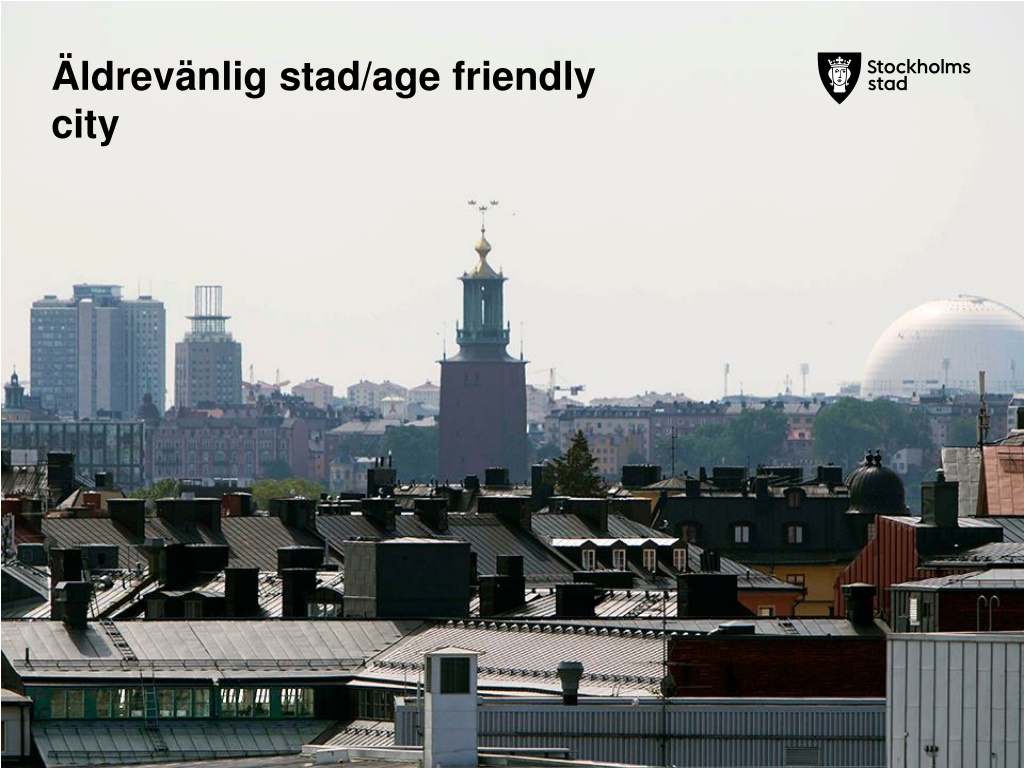
 undefined
undefined



